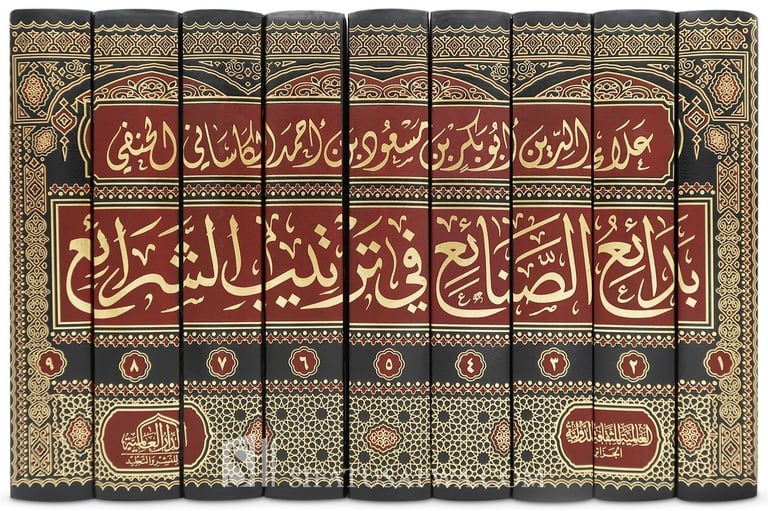UPCOMING SEMINAR: The Wife's Compass (See here)

The Ink Between Them


Samarqand, 12th century CE
The call to prayer drifted through the alleys of Samarqand like a ribbon of wind, soft, low, unhurried, brushing the silk awnings of merchants, curling through the scent of roasted almonds and parchment, brushing against the wooden lattices of madrasas where dust motes swirled like secrets in the light.
And behind one of those lattices, in a quiet study lined with books her father had copied by hand, sat a woman with eyes deeper than ink.
Fatima bint Muhammad al-Samarqandi.
The daughter of a jurist, the student of a scholar, the whisper behind a thousand legal judgments.
She had grown up among books before she could even hold them. Her lullabies were the rhythm of her father’s pen scratching across vellum. Her dolls were ink pots and folded parchment. While other girls played with bangles, she memorized Tuhfat al-Fuqaha’ - her father’s great legal work - line by line, reasoning by reasoning.
She did not study because she sought praise.
She studied because truth was beautiful.
And when she spoke, it was not with the force of rebellion, but with the stillness of certainty. The kind that blooms only when the ego has been broken in worship.
Her father, Muhammad al-Samarqandi, once told a ruler who mocked him for educating his daughter:
“You spend fortunes to raise sons who forget you. I planted knowledge in someone whose tongue remembers only Allah.”
But knowledge, like light, draws those who hunger.
One day, a man came.
Ala’ al-Din al-Kasani.
A jurist in his own right. Brilliant, sharp, respected. He sought her hand, and others did too; princes with coin-heavy names, noblemen with caravans of promise.
But her father declined them all.
Until Kasani placed a book in his hands. A commentary on his Tuhfat al-Fuqaha’. A meticulous expansion, a weaving of law and logic across every page.
Fatima read it in silence.
And when she reached the final chapter, she closed it softly and said:
“He does not love flattery. He loves truth.”
Her father nodded. The dowry was accepted. The book - not gold, not land - was chosen. Not because she lacked worth, but because worth itself must be redefined.
They united. But it was not the kind of union poets sing of under moonlight.
It was the quiet intimacy of intellect.
They said: "and then she was married"... but it was never the end of her story.
It was a beginning.
She did not sit behind her husband. She sat beside him. At times, she sat ahead.
In the days of their marriage, legal queries would arrive by letter, sealed and marked. Kasani would read, pause, write. And often, she would pass by, glance once, and say gently:
“Not this. He asked of A, and your answer lies in B. Look again at what Abu Hanifa said.”
And he would. And he would find that she was right.
Time and time again.
It was she who reviewed his rulings. She who corrected them. She who, with precision and restraint, refined the words that would shape entire schools of thought. Not in his shadow, but alongside him. A co-builder. A quiet author of clarity.
Sometimes, the seekers came from distant lands, unaware that the quiet woman behind the door was the one whose insight sharpened their verdicts. That behind the name of a man was the clarity of a woman.
At night, when the world fell to hush, she would sit in the glow of a single lamp, her husband beside her, and together they would review fatwas. She would edit, refine, explain.
She was not correcting him.
She was completing him.
He often said: “I taught the world the branches of law. But she taught me where its roots begin.”
Her voice never filled pulpits.
Her name rarely graced pages.
But in the silent margins of books passed hand to hand across centuries, her thought lives on.
Not every woman builds brick by brick, like Fatima of Fez.
Some build through breath. Through a single, quiet word at the right time.
And those words echo louder than marble ever could.
Some women build by shaping those who shape the world.
Fatima al-Samarqandiyya never founded a school.
She never asked to be remembered. But Allah records what the world forgets.
And perhaps the purest legacy is not the work you sign with ink…
But the one written because you were the light.
What Will You Shape?
Download Your Reflection Journal
Take a quiet moment to reflect on the remarkable legacy of Fatima al-Samarqandiyya — scholar, editor, and unseen architect of legal clarity. What knowledge or guidance are you quietly shaping in your world?
What’s inside?
A Reflection Worksheet with deep, thoughtful questions
A beautifully designed Poster to print and pin for daily inspiration
Ideal for: Scholars, students, educators, and anyone inspired by the strength of women shaping knowledge across generations.
Writer’s Note:
Bada’i‘ al-Sana’i‘, the dowry that won Fatima al-Samarqandiyya’s hand, would go on to become a cornerstone of Hanafi jurisprudence.
During ifta’ training, we often found ourselves returning to its pages; the way it lays out discussions is unmatched. Meticulous, layered, precise. It doesn’t just answer; it walks you through.
Kasani, in his own right, was a legal mind of rare depth… and still, she sharpened his work.
Disclaimer: Traces of Her offers a creative interpretation of the lives of Muslim women from the past. Since many aspects of their daily lives are not fully documented, much of the series is based on imagination, inspired by common human experiences, and informed by historical context. The visual depictions and scenarios aim to provide a relatable and engaging setting, helping modern readers connect with and understand our rich heritage. While the scenes are not necessarily historically accurate, they are designed to evoke the essence of what life may have been like, offering a glimpse into the past through the lens of storytelling.
